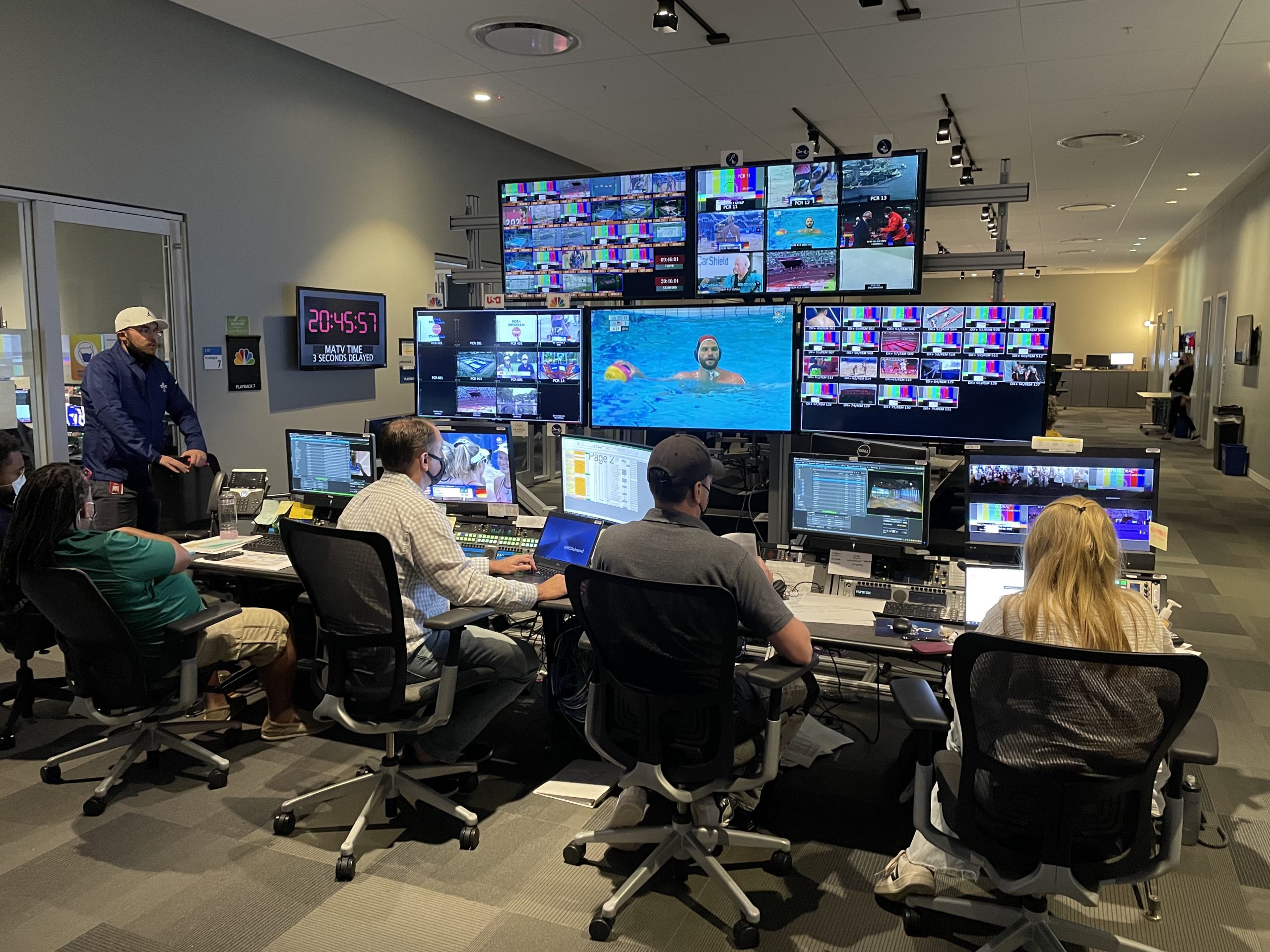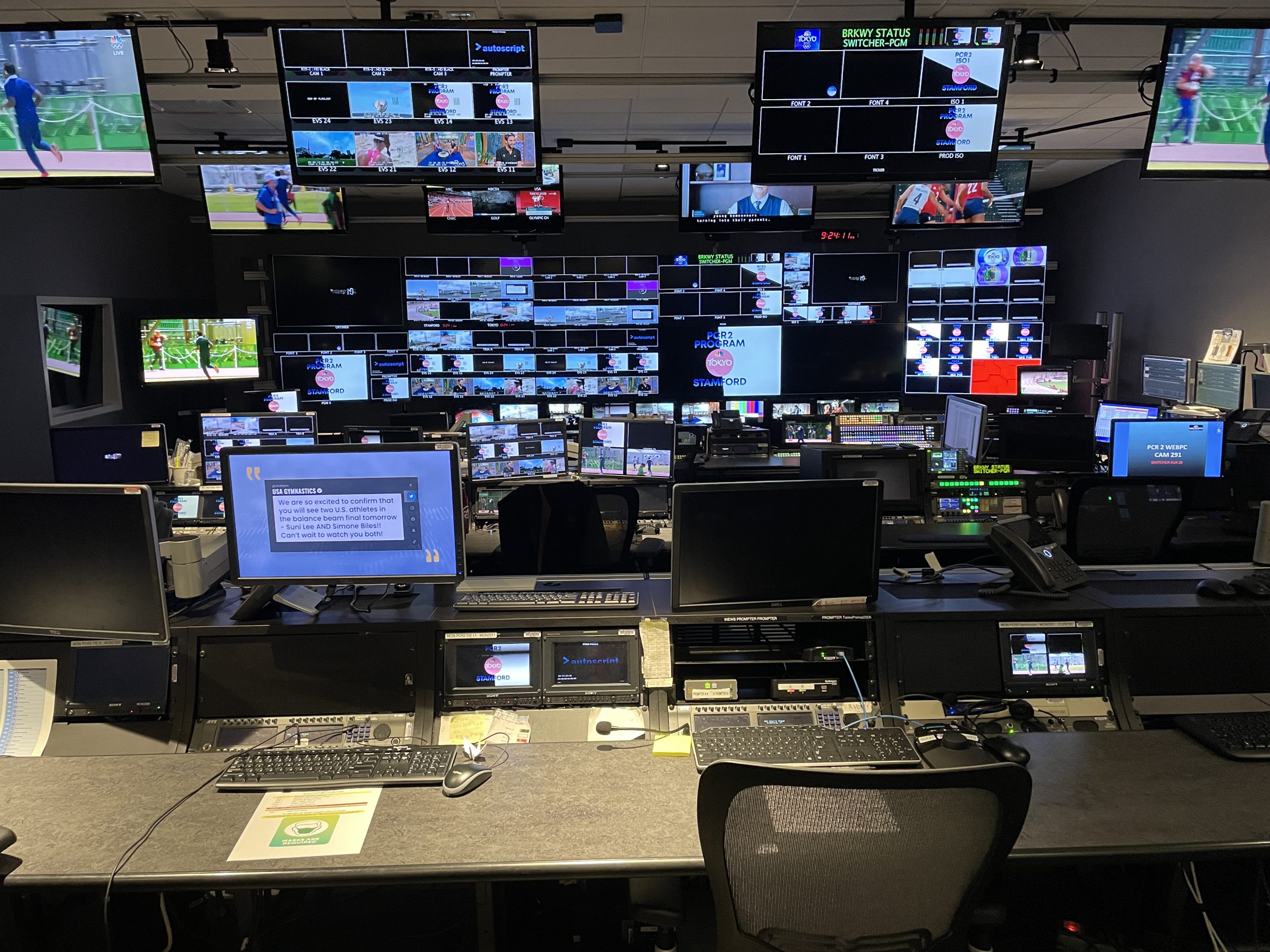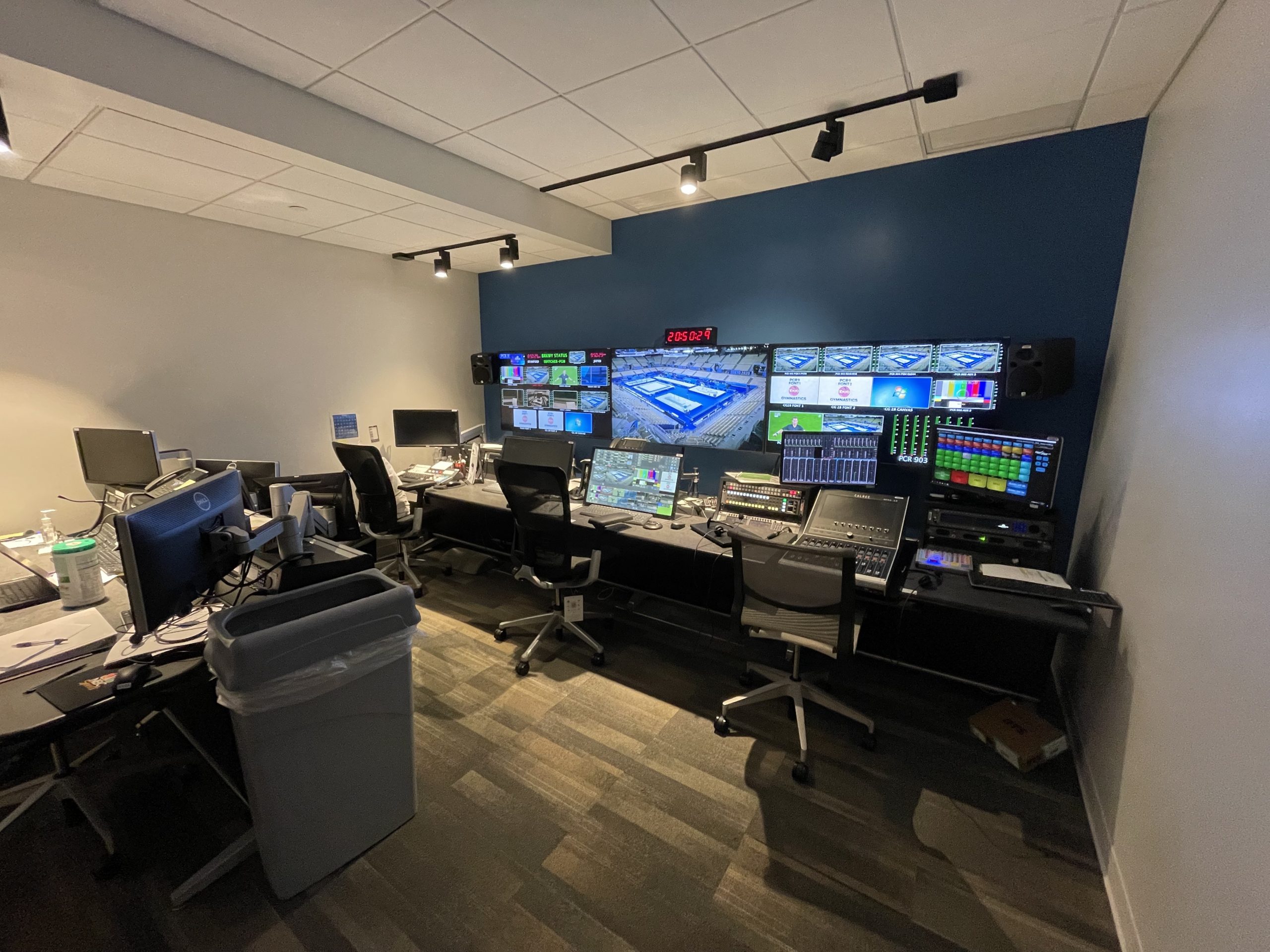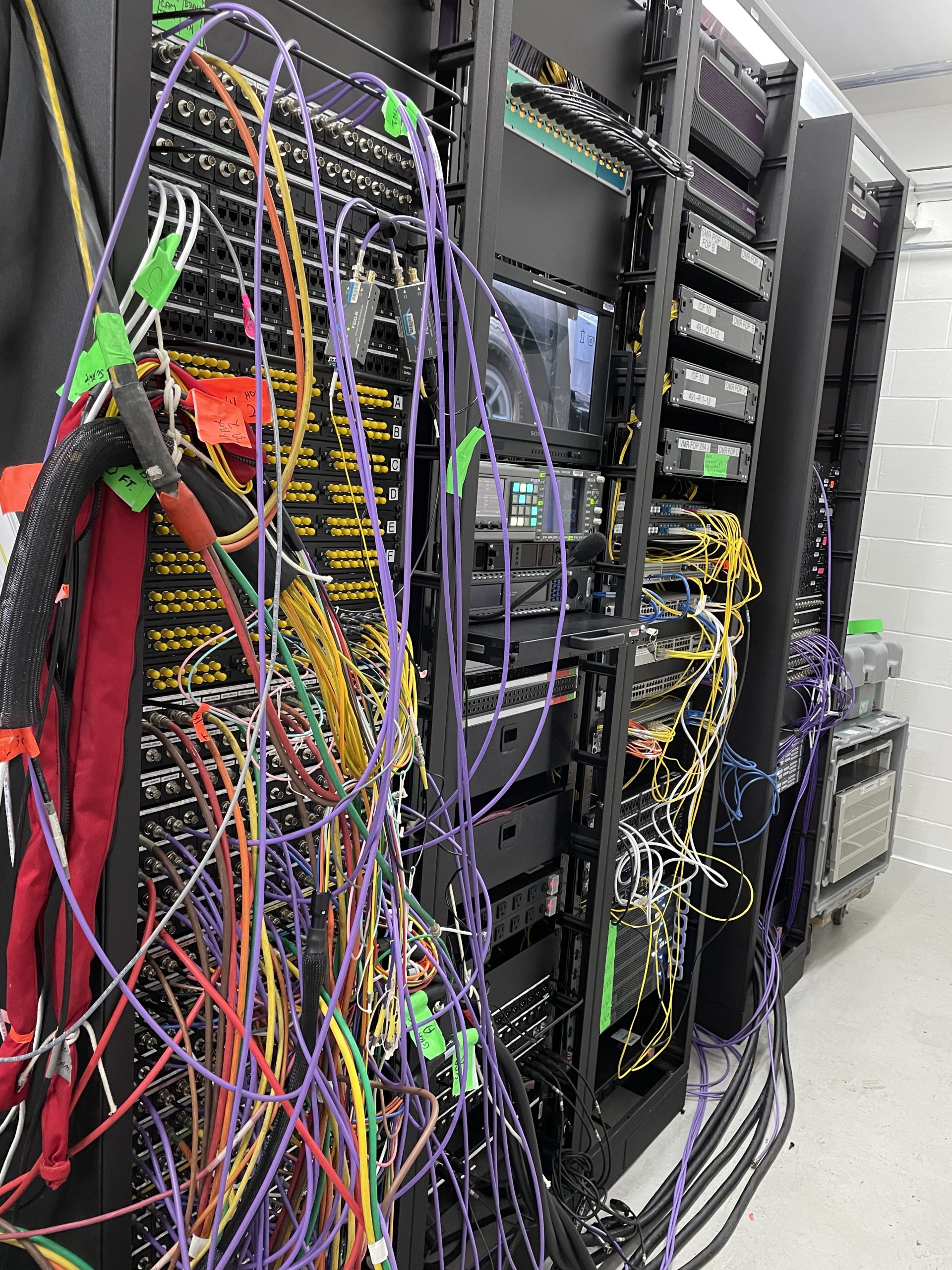NBC Stamford Spotlight, Part 2: Extra Year of Prep Boosts NBC Olympics’ At-Home Operation
GV IP router, EVS XT-VIA replay, Sony IP switchers are among the enhancements
Since launching in 2013, NBC’s Sports Production Operations Center (SPOC) in Stamford, CT, has used each Olympic Games as an opportunity to take a substantial technological leap forward. With the pandemic-mandated extra 12 months of preparation for this year’s Tokyo Games, NBC’s Stamford engineering team kicked its innovation efforts into hyperdrive.
“Of course, we always take a big step forward from one Olympics to the next, but [the delay] accelerated a lot of things that we already had on our radar,” says Tim Canary, VP, engineering, NBC Sports. “It’s almost mind-boggling how much we were able to do in such a short time out of necessity. I’m proud of what the team has done, and it’s very humbling to see how everyone pulled together to pull this off.”
Since the PyeongChang 2018 Closing Ceremony, Stamford has continued moving toward an end-to-end IP-based facility while preparing for a 4K HDR future. At the same time, Canary and company have innovated in other ways as well, including launching a trio of “micro control rooms” (two based on SimplyLive and one on Ross Video Graphite all-in-one).
More NBC Stamford Spotlight:
- Part 1: Stateside Olympics Effort Deploys Army of Studios, Control Rooms, Trucks, ‘Family & Friends’ Unit
- Part 3: Inside the ‘Off-Tube Factory’ Remote Commentary Workflow
“Technologically, I think we’re stretching the boundaries and it’s truly a technological marvel how we’ve able to do all this,” says Canary. “There were things that we thought about for years that we ended up doing simply because we had no other choice during COVID. A lot of those things that would never have been strongly considered for prime shows are now essential parts of our workflow, and we continue to harden those [tools]. It just forced us to come up with creative ways to do new things.”
Toward an IP Future: GV Core Router, EVS XT-VIA Replay, Sony IP Switchers
NBC Sports is in the process of installing a Grass Valley IP core router using GV’s Orbit Control system, UCP gateways, and XIP Frame Syncs on a Cisco leaf/spine architecture. The end-user interface is via an Evertz Magnum control system and panels featuring an Evertz BRC card to accommodate the multiple routing systems. Roughly half the content being produced in Stamford is running on this new router, including the entire Off-Tube Factory commentary operation.
“That gets us to a point where we can be completely format-independent and be fully capable of 1080p HDR 3-Gbps across the board,” says Canary. “We can also intermix 50- and 60-Hz signals on an input-by-input basis, rather than a card-by-card basis, which we absolutely had to do in preparation for [the Beijing 2022 Winter Olympics] since [China is a] 50-Hz country and we’ll still have a very large 60-Hz complement going on at the same time.”

NBC Sports Group’s central tape & ingest team benefited from the upgrade to EVS XT-VIA production servers in advance of the Tokyo Games.
In addition to the need to support mixed 50-Hz and 60-Hz workflows in Beijing, he adds, the short timeline between the Tokyo Games and the Beijing Games in February played a major role in NBC’s decision to deploy the new Grass Valley IP core router.
“Absolutely, our thinking for Tokyo was greatly influenced by our needs for Beijing,” Canary explains. “We knew we could not handle the mix of 50- and 60-Hz needs on our existing infrastructure; just wasn’t going to happen. Everything we did for that project was with an eye toward how we use it for Beijing and [whether] it meets those needs.”
In addition to the new core router, NBC completed a major upgrade in Central Tape and Ingest with the installation of EVS XT-VIA replay servers across the board. With native support for SMPTE ST 2110 and more than triple the internal bandwidth of the flagship XT3 server, the XT-VIA provides 12-plus channels of 1080p and six or more channels of UHD/4K in both SDR and HDR.
“We did a wholesale swap out of all the XT3’s for XT-VIA’s beginning pre COVID,” says Canary. “We continued that during the pandemic. Some of those machines were supposed to go to Tokyo and then come back, so we had to do quite a dance of hardware to make sure we were covered both here and in Tokyo.”

NBC upgraded PCR2’s switcher to a Sony XVS-9000 and plans to have all PCRs on current generation XVS models by next year.
In addition, during the pandemic, NBC swapped out two Sony MVS-7000 switchers for Sony XVS-9000 models in its largest control rooms in Stamford. The broadcaster also purchased another XVS-9000 for its IBC plant in Beijing. After the Winter Olympics, it will be shipped to Stamford and installed in PCR3. Two XVS-8000 switchers are being transferred from the former Golf Channel facility in Orlando (Golf Channel media operations migrated to Stamford near the end of 2020) and will be installed in PCR8 and PCR6. All control rooms will then have current-generation Sony XVS switchers.
“With those switchers and the IP router in place,” says Canary, “we’re getting very close to being [end-to-end IP]. I think the experience from the [IBC] build in Tokyo and all the learning that’s taking place there about IP will have a great influence on what we do here [moving forward] for sure.”
New Micro Control Rooms: SimplyLive ViBox, Ross Video Graphite Arrive in Stamford

PCR9 is based on SimplyLive technology and is one of two micro control rooms launched in Stamford over the past year.
Even prior to the pandemic, NBC was looking for a simple way to produce the live gymnastics show in Tokyo remotely from Stamford. After exploring a variety of solutions, Canary’s team elected to build a control room based on SimplyLive’s ViBox all-in-one production system.
“We did a lot of testing with it and were getting ready to go when the Olympics got postponed,” he says. “That gave us a lot of time to use that room for a lot of different sports, including golf, and we were very happy with the results. We ended up converting two offices into two more control rooms.”
The second micro control room is also based on SimplyLive technology but features a more powerful audio console (instead of the Allen & Heath console, a Calrec Brio 12 is interfaced to Stamford’s Calrec Hydra2 audio network), which is currently being used for the gymnastics show streaming live on Peacock.
The third micro control room is built around a Ross Video Graphite all-in-one production system and has been used to alleviate bottlenecks on larger control rooms when necessary (such as for the Stanley Cup Playoffs). Although it is not being used for Olympics content, it does play a key role serving ancillary shows displaced by the Games.
“The second SimplyLive room and the Ross Graphite room never would have gotten done had the Games not been moved [back a year],” says Canary. “Many things were tipped over the edge because of [the pandemic], and it made us have to think of new ways to do things.”
Innovation at the Truck Compound: New Interconnect Room Streamlines Ops

NBC create a new interconnect equipment room at the truck bay in Stamford in advance of the Tokyo Games
NBC has parked a quartet of mobile units at the truck dock in Stamford to aid in Olympics production. To connect the trucks with both the Stamford and Tokyo operations, the engineering team created a temperature-controlled equipment-interconnect room with gateways and 64 ins and outs to the Stamford routing system, as well as an AT&T/Media Links transmission frame that ties the trucks into the overall global transmission scheme.
The new equipment room is a result of NBC’s on-the-fly efforts to remotely produce the 2020 Kentucky Derby from Stamford.
“For the Derby during COVID,” Canary explains, “we had to quickly come up with a place to put the AT&T/Media Links frame on the dock. We took an old heavy metal announce booth, drilled some holes in it to get cables in and out, put it in the loading dock, and that was the housing for the AT&T frame. Obviously, we knew we had to do something better for Tokyo, so we built a stadium-style interconnect room at the loading dock to assist with all that.
“If we hadn’t had that extra year and been forced to adapt for the Derby,” he continues, “we wouldn’t have had the truck-bay interconnect room. Now our ability to pull trucks in and have them ready to go has been pretty great. It was certainly because the pandemic completely opened everybody’s eyes to needing that.”
All About the People: NBC Sports Staff Drives Innovation
The COVID era has seen many new technologies arrive at the Stamford facility: remote ChyronHego graphics operations for Sunday Night Football, an EEG automated closed-captioning system for Olympics live streams, and much more. However, Canary stresses, none of these innovations would have been possible without the core engineering and operations staff that powers Stamford year-round.
“It’s so easy to talk about technology,” he says, “but it’s the team behind it that truly makes the difference. Every Olympics, there are unsung athletic heroes who come out and win the gold in different sports. It’s the same thing here: people had opportunities that were just thrown at them.
“So much was added so quickly,” he continues, “that we had to ask people who had never done things on this level before to build entire systems. You don’t often give a junior heart surgeon the opportunity to do a heart transplant, but that was what we had to do — and all with COVID protocols and those challenges in place. And everyone truly delivered.”

